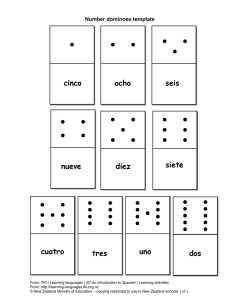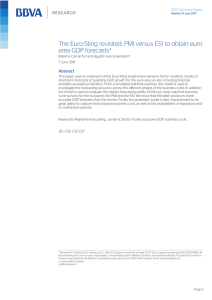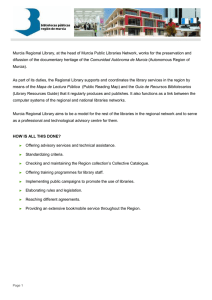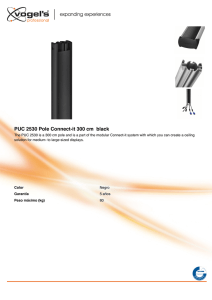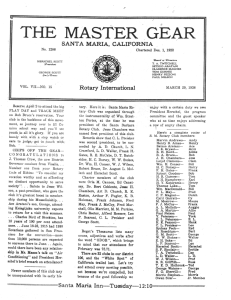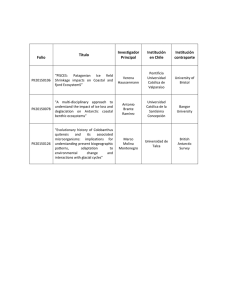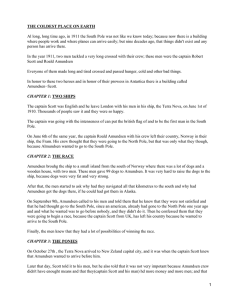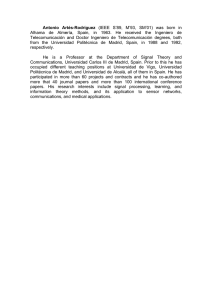A Century of News Discourse - Revistas Científicas de la
Anuncio
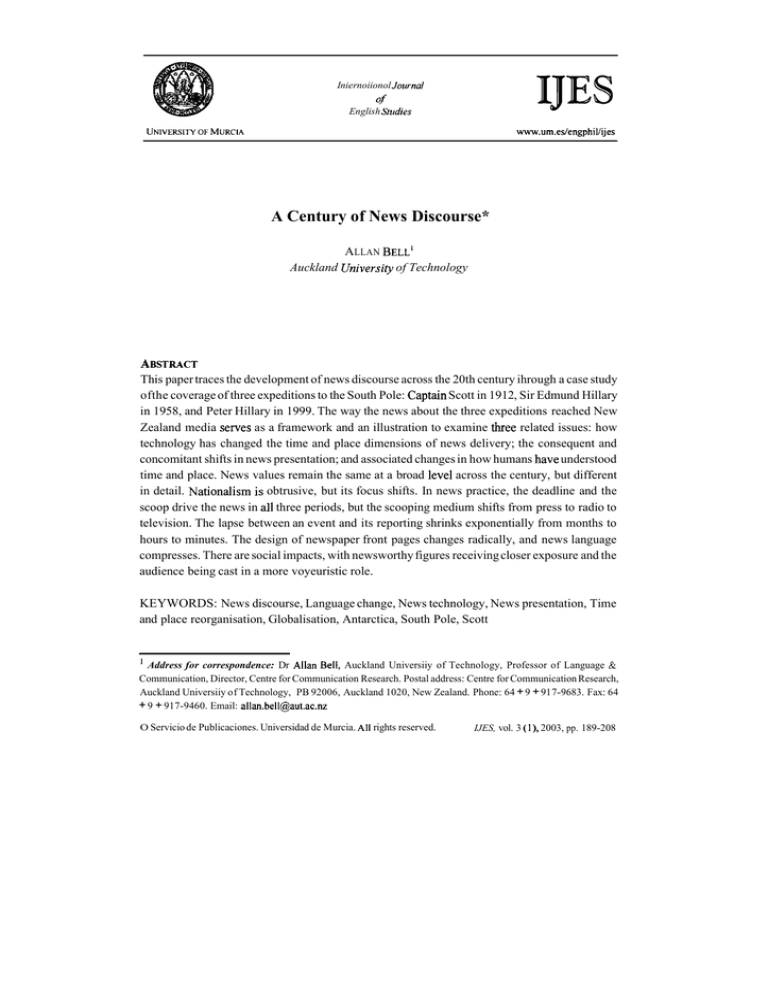
Iniernoiionol Jotrrnol Sf English Sitrdies A Century of News Discourse* ALLAN BELL' Auckland University of Technology ABSTRACT This paper traces the development of news discourse across the 20th century ihrough a case study ofthe coverage of three expeditions to the South Pole: Captain Scott in 1912, Sir Edmund Hillary in 1958, and Peter Hillary in 1999. The way the news about the three expeditions reached New Zealand media serves as a framework and an illustration to examine three related issues: how technology has changed the time and place dimensions of news delivery; the consequent and concomitant shifts in news presentation; and associated changes in how humans have understood time and place. News values remain the same at a broad leve1 across the century, but different in detail. Nationalism is obtrusive, but its focus shifts. In news practice, the deadline and the scoop drive the news in al1 three periods, but the scooping medium shifts from press to radio to television. The lapse between an event and its reporting shrinks exponentially from months to hours to minutes. The design of newspaper front pages changes radically, and news language compresses. There are social impacts, with newsworthy figures receiving closer exposure and the audience being cast in a more voyeuristic role. KEYWORDS: News discourse, Language change, News technology, News presentation, Time and place reorganisation, Globalisation, Antarctica, South Pole, Scott ' Address for correspondence: Dr Allan Bell, Auckland Universiiy of Technology, Professor of Language & Communication, Director, Centre for Communication Research. Postal address: Centre for Communication Research, Auckland Universiiy of Technology, PB 92006, Auckland 1020, New Zealand. Phone: 64 + 9 + 91 7-9683. Fax: 64 + 9 + 917-9460. Email: allan.bell@aut.ac.nz O Servicio de Publicaciones. Universidad de Murcia. Al1 rights reserved. IJES, vol. 3 (l), 2003, pp. 189-208 190 Allan Be11 1 take the media reporting of three expeditions to the South Pole as a case study in the development of news discourse across the 20th century. The expeditions are those under Captain Scoti (1910-1 3), Sir Edmund Hillary (1956-58), and Peter Hillary (1998-99). They are parallel stories of exploration and hardship, spaced across the beginning, middle and end of the 20th century. 1treat them and the way their news reached the world as a framework and an illustration to examine three related issues in the globalisation of intemational communication: (1) (2) (3) how technology changed the time and place dimensions of news delivery across the 20th century (e.g. how fast the news is received, and through what medium) the consequent and concomitant shifts in news presentation (e.g. written versus live broadcast coverage) associated changes in how humans have understood time and place across the century that is, the reorganisation of time and place in late modernity (Giddens 1991; Be11 1999). The remote location of Antarctica offers a specific advantage to these case studies: it stretches to the limits the technologies of communication and transport of the particular era, thus illustrating the boundaries of what is possible in news communication at the different periods. It also limits access to the news event to one (or few) reporting sources so that we can pinpoint the channel and timing of news despatch in a way which is becoming increasingly difficult in a world with multiple lines of news transmission. The data for these case studies consist of New Zealand media coverage of the outcomes of the three polar expeditions. Antarctica is a very present place to New Zealanders. The country is located half way between the South Pole and the equator (Figure l), and a d m i ~ s t e ras sector of the Antarctic continent. Antarctica is the nearest land to the south ofNew Zealand, which has always been the main departure point for expeditions, and remains so today for the United States operation there. In the early 20th century the South Pole was the last discovery left to make. At the time of Scott's expedition, most of the shape of the Antarctic continent was still unknown. A map published in the issue of the New Zealand Herald which reported Scott's death (1913) was able to show less than a quarter of the continent's coastline. It is aplace that remains the most isolated on earth even today. The US polar station is cut off physicaily for half the year even by air transport because temperatures at the surface are too cold for aircraft to take off. Geographicaily, the pole is the place of al1 360 degrees of longitude (here you can "walk around the world" in a few steps). It is therefore also the location of al1 time zones -and of no time zone. It is the place of biblical day lengths, where ayear is literally as a day, with the sun rising and setting once a year. It is, then, a place which shatters our conventional measures of time. The paper's theme is the way in which time and place are being re-configured in O Servicio de Publicaciones. Universidad de Murcia. All rights reserved. IJES, vol. 3 (l), 2003, pp. 189-208 contemporary society, and the role played in that process by changing communications technology, joumalistic practice and news language. When is a defining characteristic of the nature of news, a major compulsion in news gathering procedures, and a determinant of the structure of news discourse (Bell 1995). News time is time in relation to place: what matters is the fastest news from the most distant -or most important- place (cf Schudson 1987). 1will track the changes in technology and the reorganisation of timelplace across the 20th century, using the coverage of these three polar expeditions as timepoints Figure 1: Map of Antarctica O Servicio de Publicaciones. Universidad de Murcia. All rights reserved. IJES, vol. 3 ( l ) , 2003, pp. 189-208 192 Allan Be11 1. CAPTAIN SCOTT: 191211913 The British expedition led by Captain Robert Falcon Scott reached the South Pole on 18 January 1912. They hauled their own sledges 1000 miles across the world's severest environment from their base in McMurdo Sound on the edge ofthe Antarctic continent south ofNew Zealand. They found that the Norwegian Roald Amundsen had reached the pole just a month before them. On the return joumey Scott and his party died well short of their base, the last of them on or after 29 March 1912. They were found eight months later by a search party sent out as soon as the passing ofthe Antarctic winter allowed travel. The relief party also found the detailed diary which Scott kept nearly to the last to te11 the story of the calarnitous joumey. News of their gaining the pole and eventual fate did not reach the rest of the world until a year after it happened. In February 1913, the expedition's relief ship Terra Nova put in to a small New Zealand coastal town and telegraphed the news in secret to London. Local reporters pursuing the story were rebuffed. The news was then circulated from London and published in the world's newspapers on 12 February 1913, including in the New ZealandHerald, the country's largest daily. This became the archetypal late-imperial story of heroism for Britain and the Empire, which stood on the verge of the Great War that would signal the end of their pre- eminente. In 1913 the New Zealand Herald was a broadsheet (an A2-sized page), and it remains in that format in the 21st century. It tends to conservatism in editorial stance, copy and design, and used to aptly sum up its own self-image as "a quality newspaper with a popular readership". The Herald reported the fate of Scott's expedition on 12 February 1913. The front page of that issue (Figure 2) carries the sarne masthead in the same type as is used today, but the rest of the page is totally different - e i g h t columns of small-type classified advertisements. Some of these are the etemal announcements of human life which still run today -births, deaths, marriages; jobs wanted or vacant; possessions lost and found. Others are characteristic of an earlier age than our own -shipping news and domestics wanted. The advertisements carry through the first six pages of the paper. News begins on page 7 and in this issue is dominated by the Scott story. There are some two pages of coverage, nearly half the news hole, split into a score of short pieces with headlines such as: HOW FIVE BRAVE EXPLORERS DIED HEROES LIE BURIED WHERE THEY DIED: A TENT THEIR ONLY SHROUD CAPTAIN SCOTT'S LAST MESSAGE TO THE PUBLIC O Servicio de Publicaciones. Universidad de Murcia. Al1 rights reserved. IJES, vol. 3 ( l ) , 2003, pp. 189-208 A Ceniuty of News Discottrse Figure 2: N r w Zealand Heruld, 12th February 1913, front page O Servicio de Publicaciones. Universidad de Murcia. All rights reserved. 193 IJES, vol. 3 (l), 2003, pp. 189-208 The stories cover the search for Scott's party, reaction from other Antarctic explorers such as Amundsen, background on earlier expeditions, commentary on the fatalities. Two characteristics of the coverage appear here which are echoed again in the stories later in the century -first, the imperial geography of news, by which the information was telegraphed secretly to London from New Zealand, released in London, and only then transmitted back for publication in the New Zealand press. Second is the motif of the waiting wife - o n 12 February Katherine Scott was on a ship between San Francisco and New Zealand, coming to meet her husband on his return. She did not receive the news of his death ti11 a week after it was public, when the ship came close enough to one ofthe Pacific islands to receive telegraph transmissions. So we have here a "what-a-story" in Tuchman's terms (1 978), dominating the news of the day -although not of course bumping the advertisements off the front page. In terms of the categories of news discourse which 1 use to analyse stories (see Be11 1991, 1998; cf van Dijk 1988), al1 the central elements of time, place, actors, action, and so forth are present. So are the ancillary components of news as shown in the headlines over individual stories: Followup -consequences, reaction: DEAD MEN'S EFFECTS EXPLORERS DUMBFOUNDED: POLE-WINNERS' SYMPATHY EMPIRE'S GREAT LOSS: RESOLUTIONS OF SYMPATHY Commentary -context, evaluation, expectations: CAUSES OF THE DISASTER TERRA NOVA DUE AT LYTTLETON TODAY Background -previous episodes, history A STRIKING ANALOGY: CAPTAN COOK AND CAPTAN SCOTT ANTARCTIC'S DEATH ROLL: A LIGHT RECORD The most obvious differences to a modern newspaper are visual -the absence of illustration, the small type even for headlines, the maintenance of colurnn structure, and so on. What differs from later news discourse structure is that in 191 3 the information was scattered among a myriad of short stories, as illustrated by the above headlines. Each sub-event has a separate story, which contemporary coverage in this kind of newspaper would now tend incorporate into fewer, longer stories. Al1 the information is there, and the categories of the discourse are the same, but the way they are realized and structured has shifted. Turning from the general tenor of the paper and its coverage in 1913, we can focus on the specifics of the lead story, particularly its headlines (Figure 3). There are 10 decks of headlines -not something one would see in a newspaper at the start of the 21st century.' This is an extreme example because of the scale of the story, but five decks were not uncommon in the O Servicio de Publicaciones. Universidad de Murcia. All rights reserved. IJES, vol. 3 ( l ) , 2003, pp. 189-208 Herald at this period. As can be seen by the examples above, here the headlines are telling the story. In some cases they refer to other, sidebar stories separate from the story above which they are placed. By contrast the modem headline usually derives entirely from the lead sentence of the story below it (Be11 1991), and certainly not from any information beyond the body copy of that story. That is, there is a qualitative shift in this aspect of news discourse structure across the century, from multiple decks of headlines outlining the story, to 1-3 headlines which are derivable from the lead sentence, with the story being told in the body copy. * .*;- -,,.. NÉW . ZEALAND H133idL;B. -- W%DSESDAP. LrE'JEUd!XX -----_- ; I l;?. 1313. I / THRILLING OFEICIAL NARRATiVE. 7 MISIIRTUHE FOLLOWS MIIFORTUlil. .- 1 1 EVANS DIES FROM ACCEDENT. l ) -.-..A OATES SEVERELY FROSTE.TTEN. l JHORTAGE 1l $ O F FUEL A N B FOOD. i I -- -A DEPOT ONLl' ELEVEN MILES AWAY. Figure 3 : N Z Herald, 12th February 1913, p. 8 O Servicio de Publicaciones. Universidad de Murcia. Al1 rights reserved. IJES, vol. 3 ( l), 2003, pp. 189-208 196 Allan Be11 The first striking thing in these headlines is an omission -they do not tell us that Scott reached the South Pole. No headline anywhere in the coverage in fact says that he reached his goal. The story is in the party's perishing -and it has remained so, as we shall see in the coverage of subsequent expeditions.' In terms of the time structure of news stories (Bell 1995), these 10 headlines themselves form an inverted pyrarnid of time, beginning with the most recent situation in the first two decks, going back to the most distant chronological event in the fifth deck, then working chronologically through the subsequent sequence of events towards the present in the remaining decks. Let us assume that a contemporary newspaper would run a 10-deck headline like this. How would today's headline writer edit these into contemporary style? DEATH IN ANTARCTIC 1think the modem headline editor would have no problem with this, it could as easily be used today as a century ago. FATE OF CAPT. SCOTT AND PARTY The honorific Capt. would be deleted. There was a move during the first half of the 20th century away from such official, military or hierarchical titles, and towards a greater democracy of newsworthiness (Bell 1991). The abbreviation Capt. is also archaic, and par@ in this sense falls into disuse during the century. While Edmund Hillary's expedition is still referenced as a "party" in 1958 (see below), the Herald's coverage of Peter Hillary's 1999 expedition refers to the group and Hillary's team-mates. It usesparv but only in historical reference to Scott's expedition. There is thus an intertextuality here which refers to Scott using the vocabulary of reporting in his own era not the labelling current a century later. THRILLING OFFICIAL NARRATIVE This is an impossible headline nowadays - lexically because thrilling and narrative (meaning "news story") are both words of an earlier era, but more strikingly because of a shift in media and public consciousness. A century later thrilling and oficial can only be heard as mutually contradictory or ironical. Perhaps more tellingly, the concept of oficial narrative has shifted its significance. In 1913 it self-presents as the authoritative account of what really happened. The many stories about the Scott expedition published by the Herald on this day are sourced as "copyrighted official accounts", the description clearly intended to reinforce their authority. In the 21st century such a labelling characterizes one voice - the official - among others. Afier a century of growing media and public scepticism towards official accounts, the undertone is that the "official line or story" is to be regarded with suspicion. There has been a sea-change here in public and media attitudes towards authority and news sources. O Servicio de Publicaciones. Universidad de Murcia. All rights reserved. IJES, vol. 3 (l), 2003, pp. 189-208 MISFORTUNE FOLLOWS MISFORTUNE Too "soft" a headline for the press nowadays. It lacks hard facts, the repetition of misfortune wastes words, and the word is in any case too long. Linguistically it is the antithesis of modem headlining. EVANS DIES FROM ACCIDENT This would be made more specific, the multisyllabic word would again be rejected, and the temporal conjunction replace the resultative, because the temporal sequence is now taken to imply the causation - "Evans dies afier fall". OATES SEVERELY FROSTBITTEN Severely would be deleted as unnecessary detail DIES THAT OTHERS MIGHT PROCEED This sentence would become rather "dies to save others". The complementizer that plus subjunctive is archaic, giving way to the infinitive as apurpose clausal structure. Proceed again is 19th century lexicon - "continue" or "keep going" would be preferred. iN A BLIZZARD FOR NiNE DAYS Modem headlines do not start with a preposition, and this one would need a verb "stranded" perhaps. The rather static in would be replaced with more of an indication of agency - "by". The article goes, and the preposition in the time adverbial is not required. The end result would be no shorter, but much more action-oriented and dramatic "stranded nine days by blizzard". SHORTAGE OF FUEL AND FOOD As a headline, this has too many words to be contemporary. Fue1 and food would be combined as "supplies". A DEPOT ONLY ELEVEN MILES AWAY Again, the article would go (even though in this case there is some semantic loss - the zero article could be reconstructed as definite not indefinite: "the depot"). Perhaps a verb would be introduced, and the order might be flipped to keep the locational focus on Scott rather than the depot - "(stranded) just 1 1 miles from depot" Looking at the changes our mythical modem headline editor would have made, we can see both linguistic and social shifis: O Servicio de Publicaciones. Universidad de Murcia. Al1 rights reserved. IJES, vol. 3 (l), 2003, pp. 189-208 198 * * * * Allan Be11 The ideological frame has changed -there is no longer just the "official narrative", but the official becomes one account among others. The discourse structure has moved from multiple decked headlines which almost te11 the story, to single, short, telegraphic headlines which summarize the lead sentence. The lexicon has moved on. Some words strike as archaic less than 100 years later, for others length makes them out of place in a headline and they are replaced by shorter, punchier items. The syntax also has tightened. Function words drop out, there is a shift to emphasise action and agency through "by" and the introduction of verbs. An entire clausal structure ("that" + subjunctive) has become obsolete. Joumalistically speaking, the news has become harder, the language tighter. 11. SIR EDMUND HILLARY: 1958 In 1957 the British began an expedition to make the first crossing of Antarctica by land. It left from the opposite side of the continent, south of South America, headed for the South Pole, and on to what was now called "Scott Base", on McMurdo Sound, south of New Zealand (see Figure 1). There was a support expedition from the New Zealand side of the continent. This headed south from Scott Base preparing the route for the British group which would be coming the other way. The support group of New Zealanders was led by Sir Edmund Hillary, the first person -with Norgay Tensing- to climb Mt Everest (in 1953). The British side of the expedition made slow going. Hillary continued south, driving modified New Zealand farm tractors and laying supplies for the British to pick up on their way north. He eventually decided that instead of tuming back as planned, he would keep going and reach the Pole himself. This he did on 3 January 1958, the first overland expedition since Scott, and therefore only the third ever. The British party arrived at the Pole some time later and in due course completed the crossing of Antarctica along the route Hillary had prospected. Like Scott, the New Zealanders knew they were in sight of the Pole because of signs of human presence, but they were neither surprised nor disappointed to see the buildings that made up the American polar station. The group camped, slept, and were awoken on the moming after their arrival by a welcoming party of Americans who drove out to receive them and then hosted them at the polar station. The first news reached the world on radio that same evening. The next moming, 4 January 1958, it was the lead story in the New Zealand Herald. That same day the explorers flew back to Scott Base. 1cannot be sure which was the first medium to disseminate the news of Edmund Hillary reaching the pole. By 1958 the century had reached the era of electronic media, so the durable archive of hard copy had given way to the ephemera of often unrecorded radio broadcasting. This was however the period when radio ruled in New Zealand (television had not yet started), and O Servicio de Publicaciones.Universidad de Murcia. All rights reserved. IJES, vol. 3 ( l ) , 2003, pp. 189-208 A Cenrttry of A'e~vsDiscoirrse 199 1 assume that radio was the first medium to carry the news. Hillary reached the pole at 8pm at night, and reported the arrival by radio to Scott Base. He was interviewed by radio at the pole by a reporter back in McMurdo Sound. The news was relayed to Wellington, New Zealand's capital city. The then Prime Minister Walter Nash recorded a message of congratulations which was radioed to Scott Base and on to the American polar station, where Hillary and his companions heard it next moming. 1 have not yet located any archiva1 recordings of radio coverage. At this time there was still no independent radio news service in New Zealand, only distribution of govenunent communiques. The main New Zealand stations were still relaying the BBC World Service news from London. It is therefore possible that the old imperial lines of communication meant that this very local news story was -1ike Scott's- first broadcast back to New Zealand from the mother country. In the middle of the 20th century, the press was still an important breaker of news, even though radio had been added. New Zealand newspapers covered the story, which was received in Wellington from Scott Base and sent out on the NZ Press Association wire around New Zealand and the world at 10.19pm on Friday 3 January. But even in New Zealand it was not strictly speaking front page news. In 1958 remarkably little has changed on the front page of the Herald since 191 3. The masthead is the same, as one would expect, but so are the front-page classifieds, eight solid columns of small type -births, deaths, marriages, home helpers wanted, farm employees wanted-although the shipping news has gone. The type is tidier and more symmetrical, but still small. The main news still starts on page 8, and here things look different. There are photographs, and headlines run across severa1 columns. But there is much less coverage of this story than of Scott -about a third of a page. This partly reflects the increasing taming of Antarctica, which now has airfields and the South Pole base. Advances in transport have changed the perception as well as the time lag. It also reflects that this story does not involve the death of the hero -that much of news values remains constant. The headlines and copy run across 3-5 columns (Figure 4). There is a three-deck headline. The contents of the top two headlines can be derived entirely from the lead paragraph. Interestingly, the third headline comes from the lead paragraph of the second story (under ONE DRUM OF FUEL LEFT). In fact the lead story after the first two paragraphs is entirely background about Hillary's expedition, and the new news is carried in the adjacent shorter story. This probably came about because the copy for the long story was already set when news of Hillary's arrival broke in the newsroom after IOpm. This would have been shortly before the Herald's city edition was put to bed, and after the deadline for the rural edition. Thus the new news ended up being carried hastily in a short secondary story. But the main difference to 191 3 is that the news is in print next day rather than next year. O Servicio de Publicaciones. Universidad de Murcia. Al1 rights reserved. IJES, vol. 3 ( l ) , 2003, pp. 189-208 7 nn Figure 4: NZ Herald, 4th January 1958, p. 8 O Servicio de Publicaciones. Universidad de Murcia. All rights reserved. Allan Be11 IJES, vol. 3 (l), 2003, pp. 189-208 In 1958 we can see the extent to which the disastrous Scott expedition has dominated media and public perception of Antarctic exploration. Scott figures in the headline and lead, and the classic 1912 photograph of his five-man party at the pole is the main illustration. Ironically, this is the only on-the-spot shot. The photographs of the 1958 expedition members are archival, studio mugshots. Photographs of Hillary's team actually at the pole could in 1958 not be electronically transmitted or physically flown out in time. The top headline reads as slightly old-fashioned with its Sir Edmundand Paríy (compare this to the 1999 headline for Peter Hillary: Hillary S trekkers). The second deck has crisp, tight, modern phrasing, while the third strikes as dated and rather wordy with two prepositions and an article. With the internationalization of measurement, 70 miles would now be given in kilometres. The late breaking story means that much of the detail was carried on the next news day, Monday 6 January (no Sunday papers in New Zealand in 1958). That day published detail on Hillary's arrival at the pole, with a rafi of subsidiary stories, including interesting cross-cultural contrasts noted in the explorers' reception by the inhabitants of the polar station -Each American had at least one still camera and oJen a movie as well. The national and imperial overtones of the arrival were strong, but rather differently inflected from Scott's day. The British press was reported as somewhat lamenting the coverage given to Hillary's achievement, which was supposed to be a sideshow to the main British crossing party. The French and American press did not have that problem. The accounts make it clear that Hillary had acted with a certain post-imperial independent-mindedness in deciding to head for the pole himself. By 1958 we have moved from the era of communications which could take months to one which takes at most hours from the end of the earth. This is a qualitative shift, and it accompanies a shift in means of transport that enables Hillary and his crew to fly back in hours over the land they have laboured months to cross. In the discourse structure of the press coverage we can see the shift to fewer headlines, which are derived from the story leads rather than telling the story themselves. The syntax is more recognizably modern in its tightness, and the lexicon is crisp, although there are still some hang-overs from an earlier era. The front page remains 19th century in content and appearance. 111. PETER HILLARY: 1999 Another 41 years later, on 26 January 1999, the three-person Iridium Ice Trek arrived at the pole. They took 84 days to pul1 their sleds nearly 1500 km from Scott Base. Their explicit aim was to recreate Scott's man-hauled journey to the pole, and to complete the trek back. Their leader was Peter Hillary, Sir Edmund's son and a significant mountaineer and adventurer in his own right. There is video footage of Peter speaking from the top of Everest on a mobile phone to Sir Edmund, and in May 2002 he climbed Everest again as part of a documentary to commemorate 50 years since his father's original climb. O Servicio de Publicaciones. Universidad de Murcia. All rights reserved. IJES, vol. 3 (l), 2003, pp. 189-208 202 Allan Be11 The 1999 polar expedition was named for its sponsor, the ill-fated communications company Iridium. The team recorded a video diary of the joumey as they went, and Peter Hillary commentated the daily progress of the expedition by satellite phone to the media. Their arrival at the pole was videoed by Americans living at the polar station. The next day they flew back to Scott Base, having already decided to abandon the retum joumey on foot because of hardship and the lateness of the season. The expedition arrived at the Pole at 5.17pm, and the world heard of their arrival within minutes. An hour after they got there, Peter Hillary was sitting on a sledge at the South Pole doing a live audio-interview on television and talking to his wife back home in New Zealand. The main television evening news programmes in New Zealand go to air at 6pm. Early in this night's programme, One Network News (on the channel which has most of the New Zealand audience) announced that Hillary was about to arrive at the pole and carried an interview with their reporter at Scott Base. At 6.20pm, a third of the way into the hour-long programme, news of the arrival was confirmed and one of the two news anchors conducted a live telephone interview with Hillary: John Hawkesby (news anchor) Returning now to the lridium ice trekkers and news they Iiave fiiially reaclied tlie Soutli Pole. It's beeii oiie of tlie tougliest treks iii liistory tlirougli oiie of tlie world's most Iiostile enviroiiments. But after eiglit-four days aiid iiearly fifteeii Iiundred kiloinetres tlie lridium ice trekkers Iiave finally acliieved tlieir goal. Judy Bailey (news anclzor) Aloiig tlie way Peter Hillary, Eric Pliillips aiid Joii Muir Iiave coiiquered bad weather, illiiess and frostbite. But withiii tlie last Iiour they've put al1 that beliind them, reaching the world's soutlieriimost point. And joining us now live by phone from the South Pole is Peter Hillary: Peter, congratulations to you all. Has it been worth it? Peter Hillary Oh look it's - 1 inust say Iiaving got Iiere - al1 - to the South Pole - everything seems worth it, Judy. I'm sitting on my sled at exactly ninety degrees soutli, it's nearly thirty degrees below zero, but 1 wouldn't - 1 wouldn't want to be aiiywliere else. It's just fantastic. Bailey Peter, how are you going to celebrate tliis wonderful achievement down tliere? O Servicio de Publicaciones. Universidad de Murcia. All rights reserved. IJES, vol. 3 (1 ), 2003, pp. 189-208 Hillary Well 1 must say 1 tliink under different circumstances it could be very difficult but the Americaiis at tlie Soutli Pole statioii Iiave been inost hospitable. About a hundred of them came out and cheered us as we arrived at the pole and they've given us a wonderful ineal. Tliey're makiiig us feel very very inucli at Iioine. Look it's uin - I don? tliink it's going to be aiiy dificulty whatsoever. It's just wonderful to be here. Bailey Woiiderful. Here we are in a different era -obviously different from 191 3, but also from 1958. As Hillary says severa1times in the interview, he is sitting at the Pole talking live to New Zealand. The story is done in the manner of a scoop (the two main news chamels in New Zealand are intensely competitive). This is treated as a what-a-story -that is, the general rules of coverage are broken, and even for live interviews this one is very unpredictable. The coverage gives the impression that the timing of the expedition's arrival may even have been orchestrated for television, or at least that Hillary was urged to get there intime so this could be carried live, because by the next night the story would be dead. Nationalism runs strong in the story. The woman anchor, Judy Bailey, has in any case a tendency to assume +r be attributed with-amother-of-the-nation role. Here she enthuses over Hillary's achievement, lets her hands fa11 to the desk in delighted emphasis, over-smiles, and exhausts the lexicon of ingroup self-congratulation (she and Hillary produce wonderful four times in the last few lines of the transcript above). The Pole +ne of the most hostile environrnents on earth- is also domesticated in this coverage, a feature which was already present in 1958 when Edmund Hillary's team was described having a meal and shower at the polar station. This is encapsulated in Peter Hillary's phrasing about the hospitality of the Arnericans at the station -They 're making usfeel very very much at home. The domestication deepens later in the news programme when the other news anchor, John Hawkesby, does a live interview with both Peter Hillary at the pole (by phone) and his wife, Yvonne Oomen, live on camera at home in New Zealand. This is an extreme example of the private mingling with the public (cf Giddens 1991): Hawkesby Peter's able to listen to you at the moment. Would you like - do you iniiid us eavesdropping if you just like to say to Iiim - Oornen Oh no, tliat's fiiie. Darling, congratulations, I'm so proud of you. It's just wonderful. O Servicio de Publicaciones. Universidad de Murcia. All rights reserved. IJES, vol. 3 ( l ) , 2003, pp. 189-208 204 Hi1lai-y Allan Be11 0 1 1 look, lim delighted to be liere aiid 1'111- 1'iii - al1 - just glad to be talkiiig to you - iii fact I've 1 partially did it for you too darling. Oomen 1 kiiow, 1 kiiow. Publicly-oriented cliches -delighted to he here echoes Hillary's repeated phrasings throughout the interview-mix with the very private: Ipartially did itfor you too darling - Iknow, Iknow There are catches in the couple's voices as they address each other direct. The sense of voyeurism becomes acute, and during the interview Hawkesby himself refers three times to this embarrassment. He eventually closes the interview with a quip about the lawns at home needing mowing, which both neatly defuses the tension and again counterpoints the public arena with the domestic. The coverage casts Yvonne Oomen in the waiting wife role, just as was Kathleen Scott at the beginning of the century. It is a role she is clearly prepared to play, while it is equally evident from her on-air performance that she is a capable and independent woman (as was Kathleen Scott, according to the biographies). The domestication intensified the following night during the half-hour magazine programme ("Holmes") which follows the news at 7pm on Television One. On this night the programme was devoted entirely to this story. The family -Oomen, their son and Sir Edmundgathered in the studio for a live televised conversation with Peter Hillary and his two companions, now having flown back to Scott Base. There is delayed video footage of the three explorers' arrival at the pole and their reception by the Americans the previous evening. TVl makes a lot of play -in the manner of commercial media- that this is the world's first live television intewiew to be broadcast from Antarctica. We can see the domestication of the most remote place on earth by means of a technology which makes people who are there appear, live and co-present on screen, with those who are comfortably at home. This leads to a different kind of coverage. The intewiews are largely lacking in informational content. They abound in cliches, focussing on the phatic and affective. In one sense this eradicates the sense of distance and inaccessibility which was (literally) inescapable for Scott, who had no way out except to walk. Peter Hillary by contrast decides to cancel his intended retum trek because it is too late in the season and flies back to base. However, the hostility of the environment and its ability to dominate humans is still present in the explorers' comments about their trek. After the television bonanza. the press coverage is scarcely worth talking about, and this is obviously what the Herald thought too. The story in the next morning's paper is a very routine one, with a few column inches at the bottom of the front page. The front page is now the Herald's lead news page (and has been for decades). The masthead is the same but larger. Stories have single headlines, and the crisp tight wording of contemporary news style. There are photos, and teasers for the rest of the day's contents. In short, it looks a thoroughly up-to-date front page. O Servicio de Publicaciones. Universidad de Murcia. All rights reserved. IJES, vol. 3 ( l), 2003, pp. 189-208 205 .4 C'eni~rtyofnéivs Discortrse Transport plan OK but cash questions 1 htt 628:; Suicide in court , 1 ..<..,... ....... ,.,, ., . . J.,, ?" , Figure 5: NZ Heruld, 27th January 1999, front page O Servicio de Publicaciones. Universidad de Murcia. All rights reserved. IJES, vol. 3 ( l ) , 3003, pp. 189-208 The press in 1999 was very aware of being scooped by electronic media, and reduced its own coverage accordingly. The headline in the story is oddly tangential, a f o l l o w p type of headline, indicative of the Herald struggling to find an angle that the broadcast media have not already covered. Clearly no photos of Hillary's arrival at the pole had come through intime for use before deadline the previous night -we are not yet in the era of fully real-time communication. Nevertheless, the deadline and the scoop can be seen operating as news drivers at both ends of the century, from the era of the press to the era of television. IV. CONCLUSION These three cases are revealing about change and continuity in time and place, and their relationship across the 20th century. News values are the same at a macro leve1 while different at the micro level. Nationalism for example is obtrusive in al1 three cases, but its object shifts from the self-assured, late-imperial character of the British Empire at the start of the 20th century, to a New Zealand versus Britain clash in the middle of the century as the ex-colony flexes its independence, to the rather brashly media-driven celebration of a local hero at the end of the 20th century. The waiting wife is part of both scenarios, showing that the underlying domestic construction of such undertakings has changed little over the century. However, the way in which the person of the waiting wife has to behave has changed, along with the positioning of the audience, as part of the social impact of the reorganisation of time and space. For the newsworthy, exposure is now closer and more real -Yvonne Oomen is much more under scrutiny than Kathleen Scott was. For the audience, we are more voyeuristic, intruding on private lives in real time, not with the distancing of interview and the timelapse until publication. We are close up, but still of course at a distance. The hostile environment is presented as domesticated, and domestic life is introduced into the life of the expedition. News practice also shows a mix of change and continuity. The deadline and the scoop drive the news in al1 three periods, but the scooping medium changes from press to radio to television. The press is there in each case, but cast in a changing role as its ability to be first with the news is lost. There is time compression, with the lapse between an event and its reporting shrinking exponentially from months to hours to minutes. The immediacy ofthe coverage grows in another sense, with the move from the arm's-length character of print reporting, through radio's ability to carry the voices of newsmakers, to television's display of events "as if you were there". True live coverage is not quite achieved in 1999 -the arrival at the pole could not be telecast live. What we actually see is a live interview filmed a day later from back at base. And there is a shift from the official handout to the live interview as the basis of news, and from trust in the official handout to reliance on directly media-sourced information. Accompanying these shifts is a change in news presentation, discourse and language. Newspaper design changes radically, most notably from the placement of classified advertisements to news on the front page. Cross-column headlines and text increase (in part with O Servicio de Publicaciones. Universidad de Murcia. All rights reserved. IJES, VOL3 ( 1 ), 2003, pp. 189-208 A C'entuiy o f ijFeieiosDiscoi~rse 207 the technological shift from letterpress to offset), and photographs become the norm. The type size increases. Story structure is reconfigured with the shift from multiple headlines. There is linguistic compression, especially in the headlines, with function words dropped and the option for shorter, sharper lexical items. Some vocabulary is left behind as archaic. Thus the drive to linguistic compression which has characterized the development of news discourse for more than a century continues to be a major force in changing news language. NOTES: * An earlier version of this paper was published as Bell (2002), and a shorter version as Bell (in press). Acknowledgement is made to the New Zealand Herald for kind permission to reproduce the excerpts used in the paper. ' These kinds of headlines do, in fact, stiII exist, but only in eccentric, hyper-elite newspapers such as the WollStreet Journol. Here standard headlining practice includes several decks, and full sentences rather than the reduced syntax normally associated with modem "headlinese". Among the many ironies of the expedition is that Scott ensured his immortality in Antarctic exploration by dying. If he had lived and returned, he would have been the man who came second to Amundsen. As it was, his "martyrdom" completely overshadowed Amundsen's successful expedition in both popular and historical exposure -to the extent, forexample, that it did not occur to me until weII advanced in this project that Amundsen would have arguably been the more apt case for comparative purposes than Scott. Amundsen's news of attaining the pole was transmitted within three months of the event, when his ship arrived in Hobart, Tasmania, on 7 March 1912. O Servicio de Publicaciones. Universidad de Murcia. All rights reserved. IJES, vol. 3 ( l ) , 2003, pp. 189-208 208 Allan Be11 REFERENCES Bell, Allaii (1991). The language of news media. Oxford: Basil Blackwell. Bell, Allaii (1995). News tiine. Time & Sociefy 413: 305-28 (Special issue oii "Time, culture & represeiitatioii". ed. Stuart Allaii). Loiidon: Sage. Bell, Allan (1998). Tlie discourse structure of iiews stories. In Allan Bell & Peter Garrett (Eds), Approaches fo media discotrrse. Oxford: Blackwell Publisliers. 64-104. Bell, Allaii (1999). Media laiiguage aiid represeiitatioiis of ideiitity. ThemaS en Trends in de Sociolingtiisfiek3 (ToegepasfeTaalwefenschapin Arfikelen [Papersin Applied Lingtrisfics]6212). 57-71. Bell. Allaii (2002). Dateliiie, deadline: jouriialisin, laiiguage aiid tlie reshapiiig of tiine aiid place in the inilleiiiiial world. 111 James E. Alatis, Heidi E. Hainiltoii & Ai-Hui Tan (Eds), Geoigefown UniversiQ Rotlnd Table on Langtlages and Ling~risfics2000 - Linguisfics. Language. and [he Professions: Edrrcafion. Jotrrnalism. Law. Medicine, and Technology. Washington, D.C.: Georgetowii Uiiiversity Press. 46-66. Bell, Allaii (iii press). Poles apart: globalisatioii aiid the development of news discourse across the 20th ceiitury. 7'0 appear ¡ti Jean Aitcliisoii aiid Diana Lewis (Eds), New Media Discorrise. London: Routledge. Giddeiis. Aiitliony (1991). ModerniQ and self-idenfify: Self and sociefy in fhe late modern age. Cainbridge, UK: Polity Press. Scliudsoii, Micliael (1987). Wlien? Deadliiies, dateliiies aiid liistory. 111Roberi Karl Maiioff & Micliael Scliudsoii (Eds): Reading fhe news. New York: Paiitheon. 79-1 08. Tuchiiiaii. Gaye ( 1 978). Making news: A sfudy in fhe consfrucfionof realifj. New York: Free Press van Dijk, Teuii A (1988). Nt.icls as discourse. Hillsdale, NJ: Lawreiice Erlbauin Associates. O Servicio de Publicaciones. Universidad de Murcia. All rights reserved. IJES, vol. 3 (1), 2003, pp. 189-208
